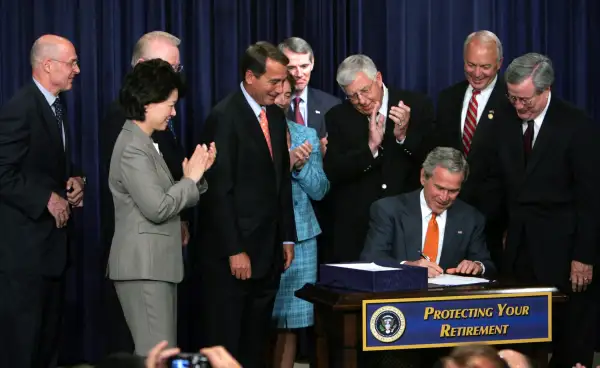5 Ways This Landmark Law Changed Retirement Saving

This Wednesday, Aug. 17, marks the 10-year anniversary of a landmark federal law that transformed the way we save in 401(k) plans. Designed to improve retirement security, the Pension Protection Act (PPA) of 2006 imposed new requirements for 401(k)s that encouraged employers to improve their plans and make it easier for workers to take advantage of them.
A decade later, it's clear that the PPA did not solve the retirement crisis—and critics have highlighted many of the shortcomings that still remain in 401(k)s. Still, on the legislation's 10-year anniversary, it’s useful to look at how dramatically the 401(k) system has evolved and in what ways these reforms have encouraged workers to put away more money for retirement.
Here's how the PPA is playing out in five key areas:
1. Ease of enrollment
If you join an employer today, you are likely to be automatically enrolled in a 401(k) plan—with little or no effort on your part—unless you opt out. Some 61% of 401(k) plans use automatic enrollment, compared to just 35% in 2006, according to T. Rowe Price.
The move to automation has sharply improved participation rates among eligible workers. Among plans that use automatic enrollment, participation rates average 88%, according to T. Rowe Price senior financial planner Judith Ward. By contrast, in plans where enrollment is voluntary, participation rates average just 48%.
2. Better portfolio diversification
Almost all 401(k) plans with automatic enrollment default workers into some type of balanced fund—one that holds both stocks and bonds. The most common default options are target-date funds, which are offered by 73% of 401(k) plans, T. Rowe Price reports. With a target-date fund, you get instant diversification and an asset mix that shifts to become more conservative as you approach your retirement date.
Prior to the PPA, most 401(k) used safe, low-return assets, such as stable value and money market funds, as the default investment. Since workers tend to stick with the default choice, many saw little growth in their 401(k) accounts. By contrast, between 2011 and 2015, the average 401(k) account earned a 7% return, according to Vanguard data.
The PPA also discouraged the use of company stock in 401(k)s by requiring employers to allow workers to diversify out after three years. Since then the percentage of assets held in employer shares has declined sharply. (The 2008-2009 financial crisis, which hammered the stocks of many large employers, was another disincentive.) Now, 26% of plans offer employees company shares, with an average allocation of just 12% vs. 34% of plans in 2006, with an average stake of 22%, according to benefits consultants Callan.
3. Greater tax diversification
Some 62% of plans now offer a Roth 401(k) option, up from 31% in 2007, according to T. Rowe Price. With a Roth 401(k), you make after-tax contributions to your account, and your money grows tax-sheltered. At retirement, qualified withdrawals can be made tax free. By contrast, traditional 401(k) contributions are made pre-tax. Although the money grows tax-sheltered, you will pay taxes on withdrawals.
“We think the Roth 401(k) should be the default option for younger workers, who are typically in lower tax brackets now and get less tax benefit from pre-tax savings,” says Ward of T. Rowe Price. Many of these younger workers are likely to be in higher brackets later on, which will make tax-free withdrawals from a Roth more valuable.
Of course, it’s impossible to know for sure how your tax bracket will change in the future. So most financial planners recommend diversifying your savings among both pre-tax and after-tax accounts. A Roth 401(k) makes that easy to do. In your 401(k), you can stash away up to $18,000 a year ($24,000 if you're 50) vs. just $5,5000 (or $6,500) in a Roth IRA.
4. More workers are saving, but average rates are lower.
Automatic enrollment has a downside. More workers are being signed up, but plans tend to default at a contribution rate of 4% of pay or less. Only about 45% of plans that use automatic enrollment also automatically hike contribution rates. Those that do usually step up the rate by one percentage point a year, so it can take a long time to reach the optimal rate, which is typically 10% to 15% of pay.
“Automatic enrollment, by itself, is detrimental to retirement savings,” says Alicia Munnell, head of the Boston College Center for Retirement Research.
Without the push from automatic escalation, workers tend to stick with their initial default rate, which is often lower than what they would have chosen otherwise. The average contribution rate for those automatically enrolled is 6.1%, vs. 7.2% for those who signed up voluntarily, according to Vanguard data. Overall, the employee contribution rates declined slightly—in 2015 the average rate was 6.8% of pay vs. 7.3% in 2006.
5. Highlighting the costs of cashing out doesn't stem 'leakages'
In some areas, the PPA has had little or no impact. The legislation mandated that plans offer hardship withdrawals for certain expenses, as well as notify workers of the consequences of cashing out when leaving an employer—you will generally owe taxes as well as a penalty, if you're under age 59 1/2.
But workers tend to pull out their savings anyway. A study by the Employee Benefit Research Institute found that 37% of job-changing workers who cash out do so because they need the money, but the remaining 63% do so because "it's the easiest path available." Without rule changes, some $10 billion in retirement savings will be lost over 30 years, according to EBRI.
Read next: Your Retirement Health Care Tab: $260,000
The greatest risk of leakage falls on millennials and Gen X—one out of three have cashed out when changing jobs, according to a recent survey, vs. one of four boomers. "We've seen the limits of what the PPA can do, so we need shut down some of these loopholes," says Munnell. Time to start working on the next landmark retirement legislation.
